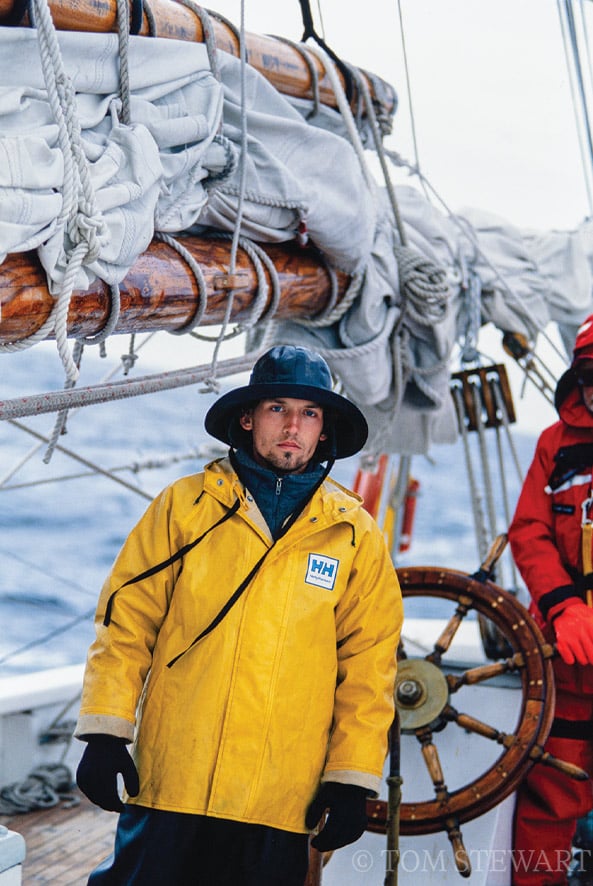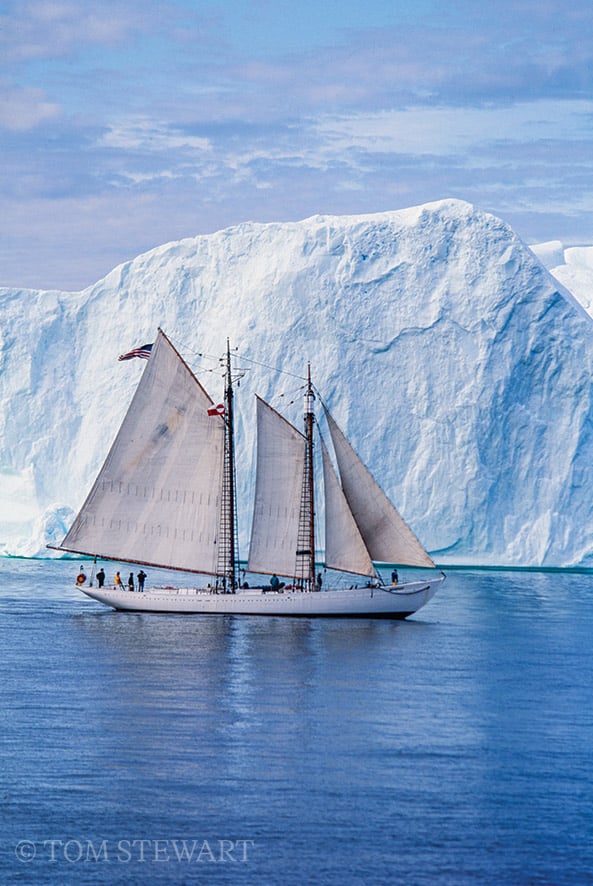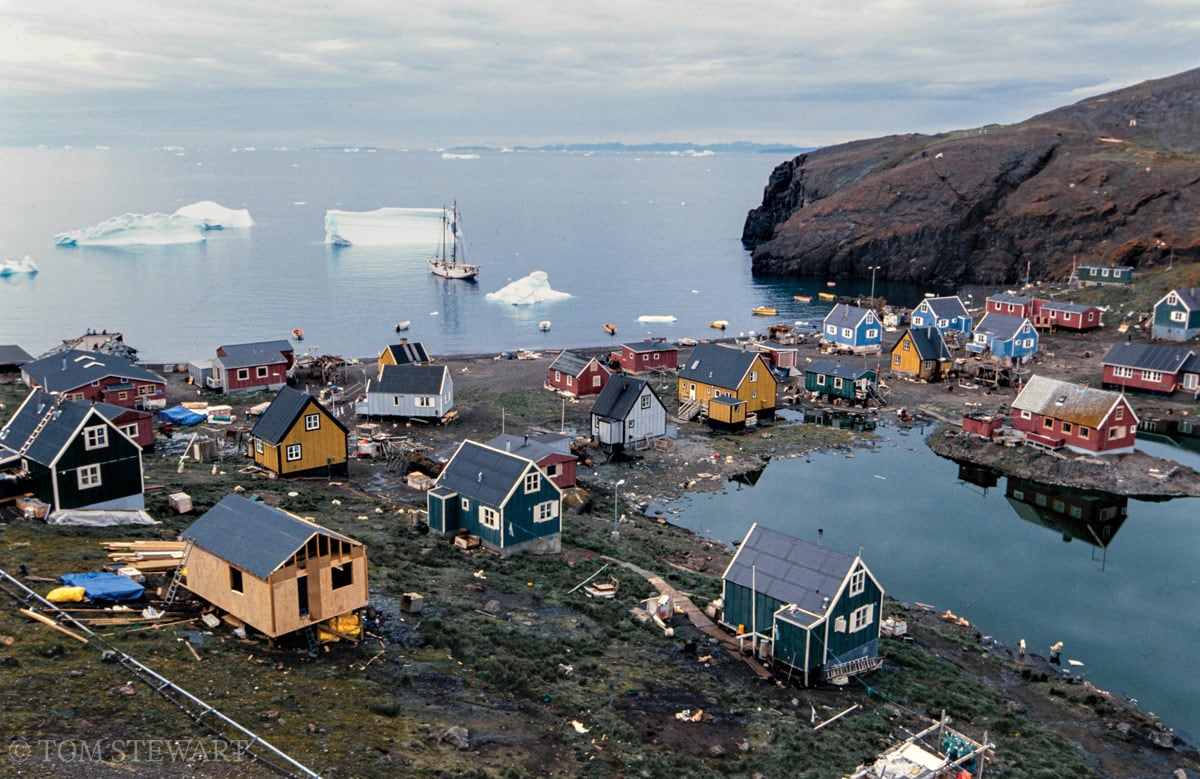From our October 2021 issue
One hundred years ago this month, the schooner Bowdoin had just completed the first leg of its maiden voyage, a research trip across the Arctic Circle, sponsored by the Carnegie Institution, and the ship and its crew were settling into their icebound winter harbor, off the west coast of Canada’s Baffin Island. The Bowdoin’s captain, Admiral Donald B. MacMillan, wrote home, “The boat is a wonder” — and not without pride, for it was he who had designed it. An 88-foot, two-masted auxiliary schooner (that is, a sailing ship with an engine), the Bowdoin was purpose-built for Arctic exploration, with ingenious adaptations to navigate and survive collisions with ice floes, including watertight bulkheads and a rounded hull, the better to ride up on floes that would crush a straight-sided hull.
Built and launched in East Boothbay, the Bowdoin made 26 trips to the Arctic with MacMillan, carrying scientists and students, between 1921 and 1954. It did a stint as a naval vessel during World War II, fell out of sailing condition as a museum piece at Connecticut’s Mystic Seaport in the ’60s, then was restored to become a charter ship and educational vessel in the Gulf of Maine for much of the ’70s and ’80s. In 1986, the Bowdoin was named Maine’s official state vessel, and two years later, it was purchased by Maine Maritime Academy, where it remains the college’s flagship vessel.
At the dawn of its eighth decade, the schooner Bowdoin made two triumphant return trips to the north, first to Labrador’s northernmost permanent settlement, in 1990, then to Greenland and across the Arctic Circle, in 1991. Maine photographer Tom Stewart was along for portions of both voyages, plus another to Greenland in 1994. Thirty years ago, Down East was among several publications — from WoodenBoat to Life — to publish Stewart’s images, and it is a privilege to do so again, celebrating the centennial of one of Maine’s most storied ships.
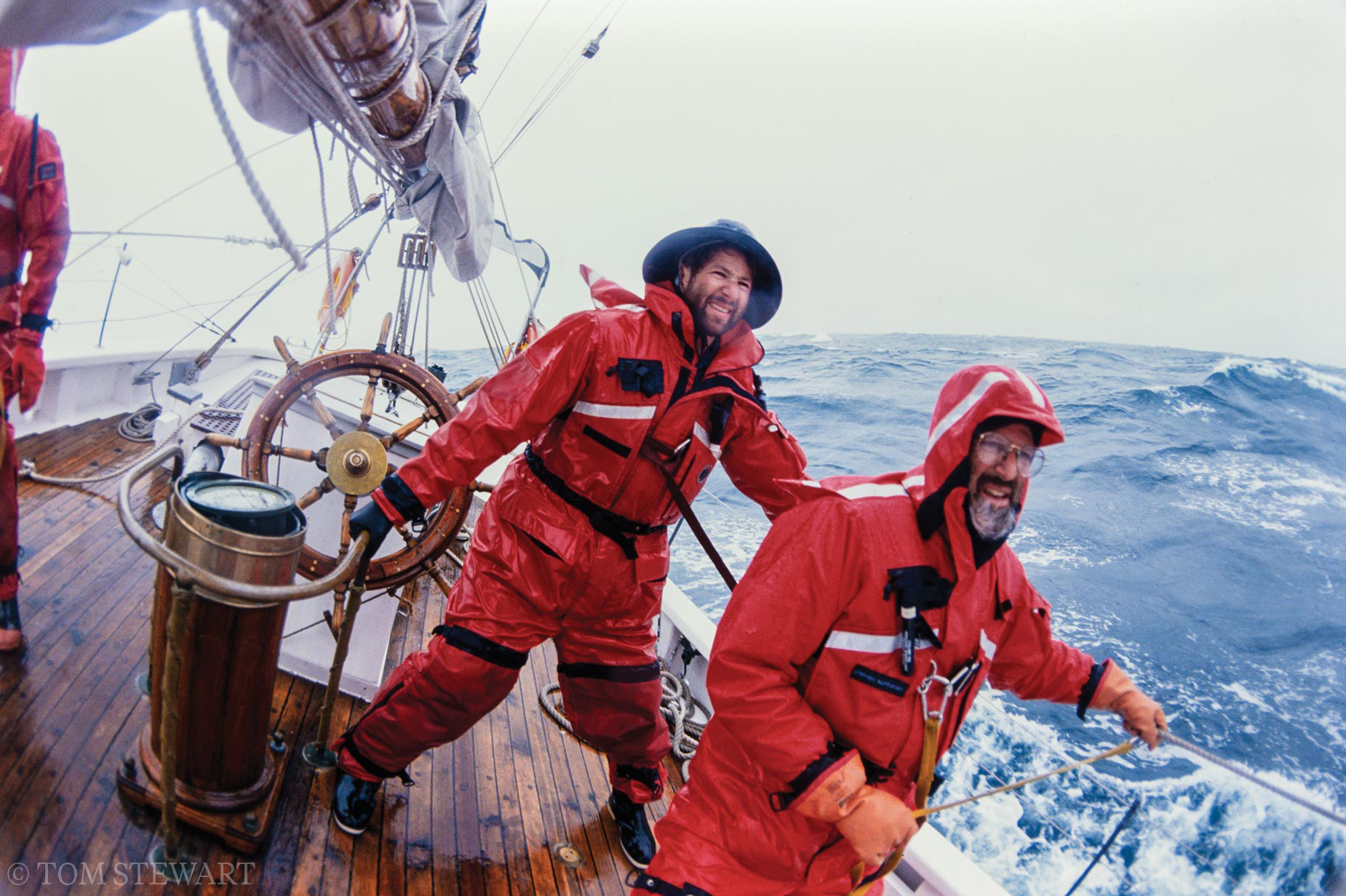
Above: Only on the 1994 trip did the Bowdoin encounter truly rough weather. “Thirty-foot seas for about 18 hours,” Stewart says. “As soon as I came up on deck, more than halfway through the storm, instantly I had to take off my glasses, since they were salted up. I just couldn’t believe the mountainous waves coming at us.” Holding the rail around the binnacle is Captain Elliot Rappaport, the Bowdoin’s skipper in ’94.
Top of page: To photograph the Bowdoin at sea, Stewart and a companion climbed into an Avon inflatable with a 10-horsepower engine. In 1991, in Disko Bay, on Greenland’s west coast, the ship passed an iceberg with a dramatic arch. “We went around that iceberg so we could anticipate when the Bowdoin would slowly sail into view, and then I’d be shooting like crazy,” Stewart recalls. “Afterwards, we contemplated zooming through the arch, then decided no, it’s too risky. Moments later, a piece of ice the size of a Volkswagen dropped from the arch’s roof. It was like a cannon shot, with all these echoes.”

At anchor in Greenland. “In pretty much any town or settlement,” Stewart says, “if you go to the outskirts, you’re going to see lots of sled dogs tethered or chained. When I was there, they had double the population of seld dogs than they have now. Snowmobiles have taken over some of those duties, but on account of climate change, there’s less ice cover for more of the year, so they’re doing a lot more hunting and fishing by boat.”



The schooner Bowdoin sailed for the Arctic with 16 aboard: its captain, a hired crew of four, 10 Maine Maritime Academy students, and a guest. For several weeks of each trip, that was Stewart, who joined at port in the Maritimes. Students still crew the ship today, though it hasn’t been to the Arctic since 2008.

This was the first iceberg the schooner Bowdoin encountered on its first return trip, in 1990. “What I like about the image,” Stewart says, “is that it’s a northbound Bowdoin — and the north is where she belongs — and a southbound iceberg, and they’re like passing ships, old friends that haven’t seen each other for many decades.”



“It would just break my heart to go past one iceberg after another,” Stewart remembers, “these giant beautiful sculptures, every side different, with some areas luminous or translucent and others reflective, like polished ivory. And I’d have to be reminded that this is not a photo-shoot trip. I quickly learned to squelch my ambitions and wave goodbye to all this beauty, hoping that something else would come our way and we’d be close enough to get some dramatic photos.”
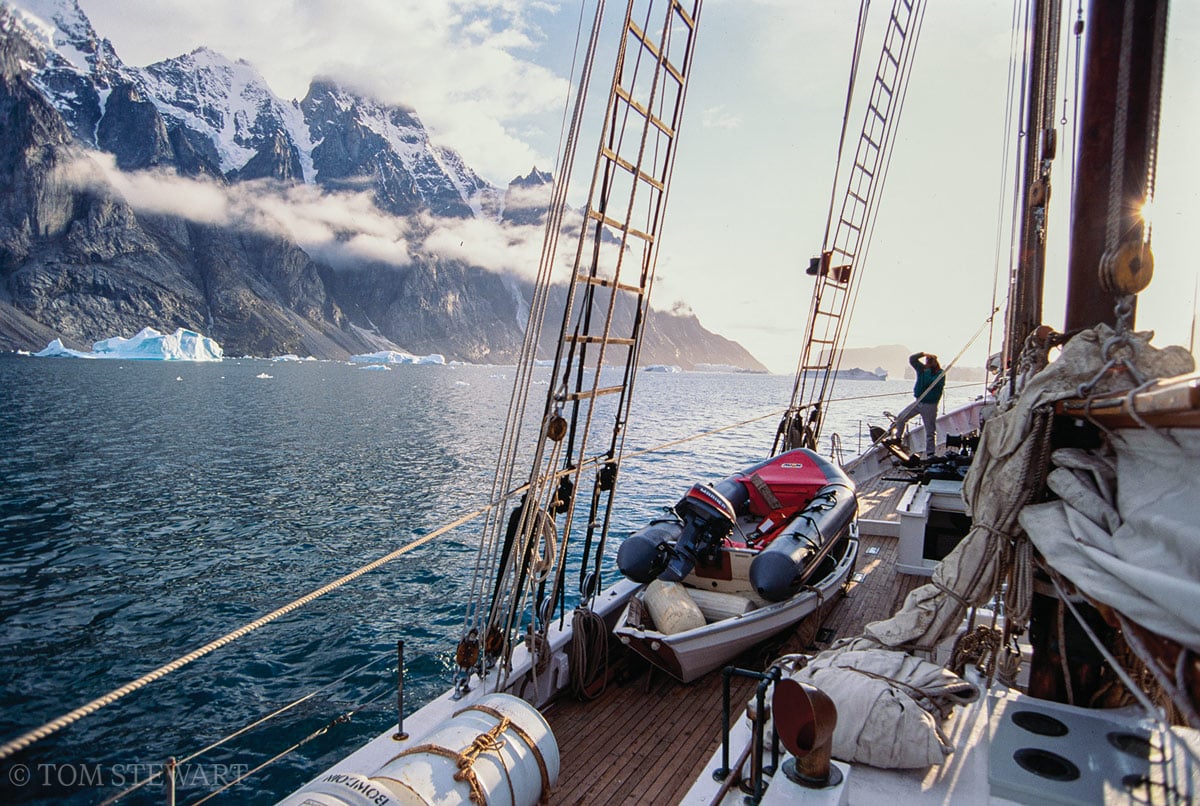
In Greenland’s Sullorsuaq Strait, some 250 miles north of the Arctic Circle. “What you see on that port side is mirrored on the starboard side as well,” Stewart says. “It was a magical place. Everybody was just standing on deck in awe.”
In the Greenland settlements where the Bowdoin anchored, wooden kit homes were once color coded by function: yellow for hospitals and doctors’ homes, blue for fish processors and their workers, etc. Along the Greenland and Labrador coasts, many elders remembered MacMillan’s visits decades before.
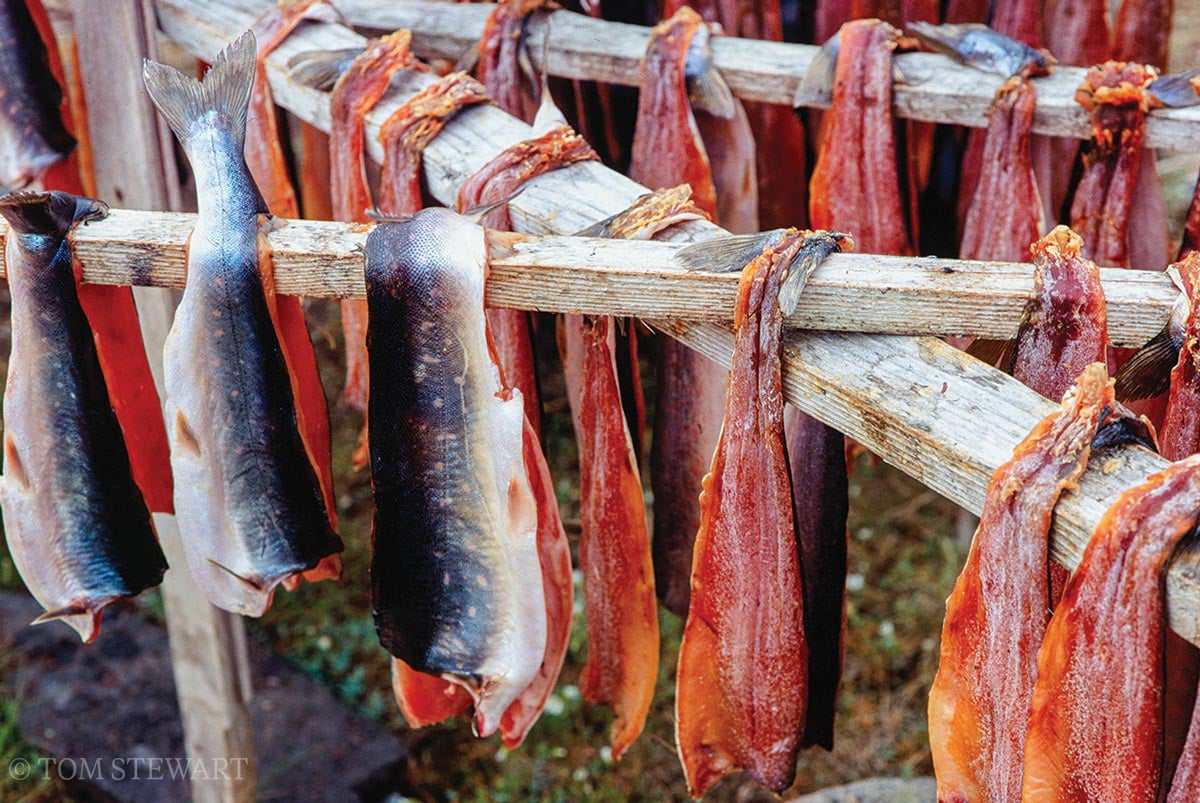
On a hike while anchored in Greenland, Stewart came over a ridge to find an Inuit fishing camp, where families smoking Arctic char on wooden racks invited him to share a meal. “We all sat in a circle and used our fingers to eat fish nuggets in a broth,” he remembers. “There was a lot of giggling. . . . I took Polaroids and passed out photos, and it was a really feel-good moment. Then I waved goodbye and went over the ridge, and they were gone. It felt almost like a dream.”
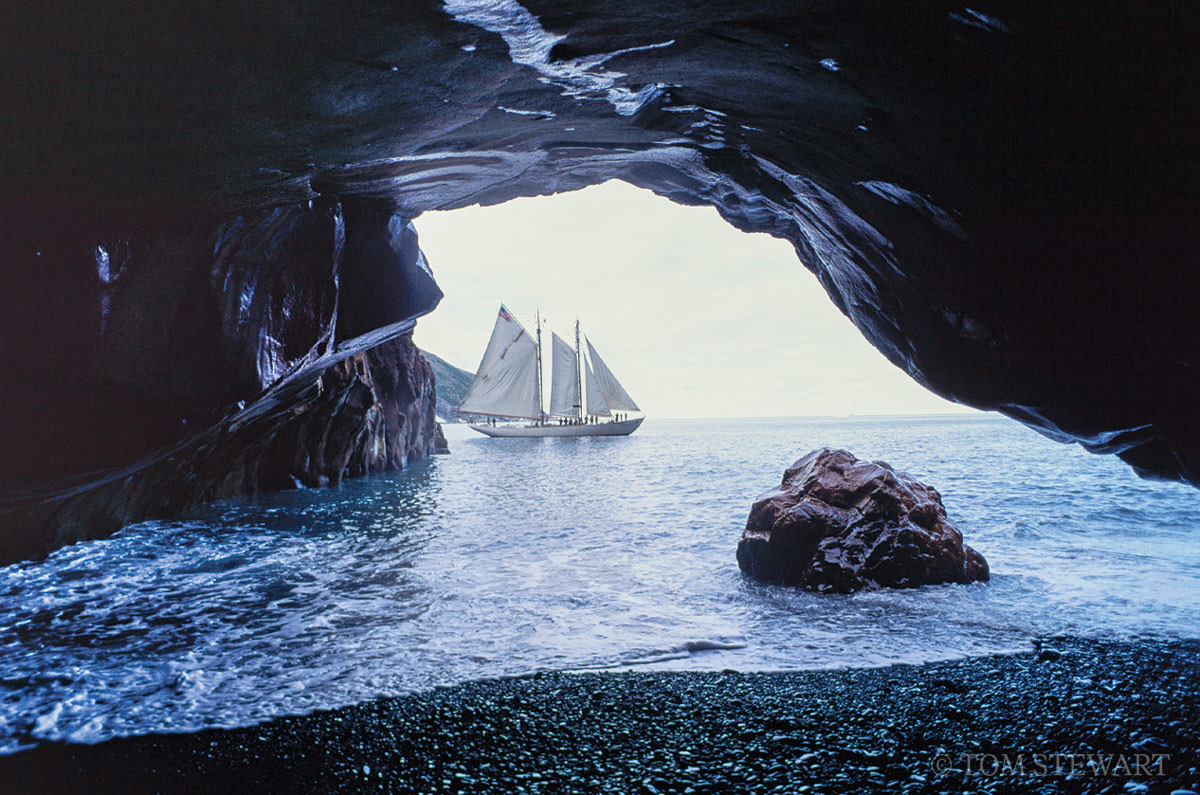
“This was on the Labrador coast,” Stewart recalls. “Captain Andy Chase was curious about this cave and brought us close enough that three of us could come ashore in the inflatable. And it was just beautiful, a perfect place where pirates could bury their treasure. So I just waited for the Bowdoin to drift into position and then snapped the shot.”
“The most magical experience for me was in Sisimiut, Greenland, in 1991,” Stewart recalls. “We were at the town hall, being welcomed by an official, and we had these old National Geographic articles about the Bowdoin. One woman, tears welled up in her eyes at a photo of a teenage girl in sealskin pants and beadwork, in front of a picket fence. It was a photo of her, from 1926. Kitura Poulsen was her name, and she was willing to recreate the photo. Three years later, I went back with giclée prints to give her, and she had passed away. I left them with her relatives.”
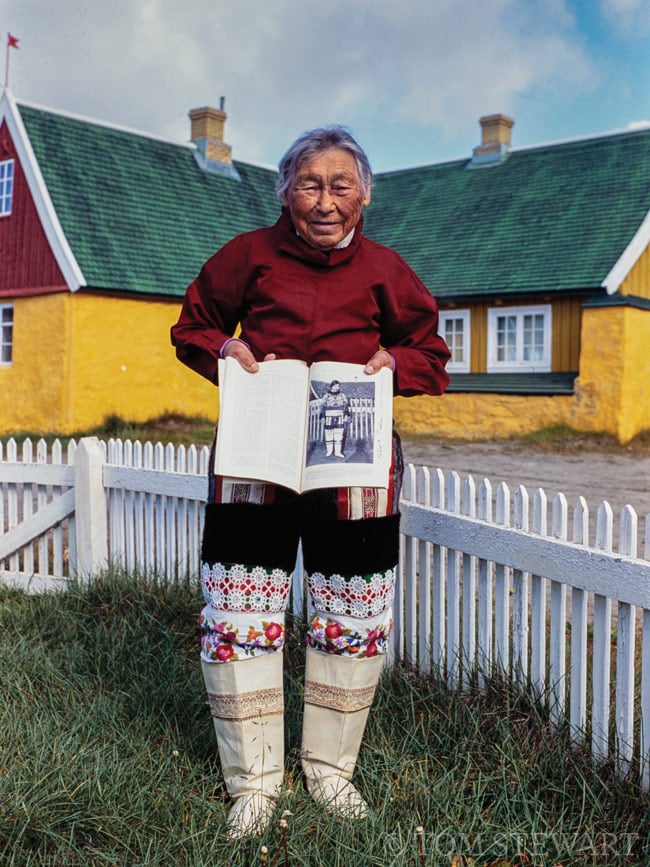

“There were caves that are deeper than they were high,” Stewart remembers. “In the inflatable, we went way into the back of one very much like the one in this photo. I thought it would be a very cool photograph looking out, and it was a cool photograph, but we were way back in there with the engine idling, and all of a sudden we heard this big, deep groan. It was scary. We shut the engine off and pulled the oars out and paddled, quietly but as quickly as possible, to get out of harm’s way. And I never did that again. I have such respect for the unpredictable nature of icebergs.”

Stewart took this shot while motoring in the inflatable over a shoal — the intense blue of the foreground is on account of the water being only two or three feet deep. “The Bowdoin is on the other side of the arch,” he says, “and you can see that arch isn’t going to be an arch much longer.”

Captain Andy Chase, who skippered the boat in ’90 and ’91, was master of the schooner Bowdoin during its early years at Maine Maritime Academy, where he is now an emeritus professor of marine transportation. Stewart, who lives five-and-a-half miles up the Bagaduce River from MMA’s campus, in Castine, still visits the ship from time to time. For years, he paddled downriver several days a week, then touched the bow of the Bowdoin for luck before turning around and paddling home.




